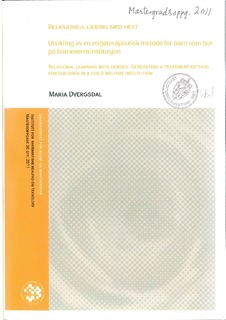| dc.description.abstract | I denne studien har jeg utviklet en miljøterapeutisk metode for barn som bor på barnevernsinstitusjon - relasjonell læring med hest. Studiens problemstilling er: Hvordan kan stell og bruk av hest utvikles og systematiseres som miljøterapeutisk metode for å styrke barnas lærings- og utviklingsmuligheter. For å belyse denne problemstillingen har jeg gjennomført et fire ukers prosjekt med hestedager hver tirsdag og torsdag for fire barn som bor på en barnevernsinstitusjon. Datainnsamlingen ble gjort gjennom deltagende observasjon i feltet, og gjennom samtaler med barna hvor vi skrev på ”Mestringskort” som jeg hadde laget på forhånd.
Studiens teoretiske grunnlag hviler på relasjons- og tilknytningsteori og relasjonell og erfaringsbasert læringsteori. Tilknytningsteorien synes nyttig som bakteppe for forståelsen av utfordringene barna kommer inn i institusjonsmiljøet med. I miljøterapi vil det imidlertid være viktig å være åpen for at barn kan vokse og forandre seg. Tidligere erfaringer og opplevelser setter ingen absolutte grenser for barns fremtidsmuligheter. Relasjonell læringsteori tar nettopp utgangspunkt i en tro på menneskets endringspotensial. Én grunntanke i denne tradisjonen er at mennesket er lærende og at det stadig kan utvikle seg.
Empirien består av sitater og beskrivelser av hendelser fra feltarbeidet. Gjennom drøfting i forhold til relasjonell læringsteori belyses eksempler på bruk av hest i miljøterapi, sosiale ferdigheter som barna har fått trene på under prosjektperioden, hvordan barna har fått oppleve mestringsglede gjennom én av aktivitetene vi har utført – voltige, og til slutt hvordan barna har opplevd denne bruken av hest. Skildringen av barnas opplevelser av hesteaktivitetene er hovedsakelig tuftet på samtalene med barna og hva de skrev på mestringskortene. Barna fikk sette kortene i hver sin perm slik at de kunne samle på mestringsopplevelsene sine og hente dem fram igjen.
Bruk av hest i miljøterapi synes å fungere godt for disse barna. I samværet med hesten kunne spente relasjoner nedtones og barna kunne få tillit til og trening på å etablere relasjoner, få trene på sin mestringsevne og derigjennom få styrket tro på seg selv som ”en som kan”.
Abstract
In this study, I have developed a therapeutic method for children living in a child welfare institution – relational learning with horses. The following approach was used: How can caring for and working with horses be elaborated and systematized to become a therapeutic method helping children to strengthen their capacity for learning and developing? In practice, I carried out a project comprising four weeks of ”horse days” every Tuesday and Thursday for four children living in a child welfare centre. Data was collected through participant observation in the field, and through talks with the children. In these talks, notes were made on the ”mastery cards” I had created.
Theoretically, the study rests on relational and attachment theory, and on relational and experience based learning theory. Attachment theory serves as a useful way of comprehending the challenges carried by the children as they enter the child welfare centre. In therapy, it is, however, important to realise that children can grow and change. Early experiences set no absolute limits for children’s possibilities in the future. Relational learning theory is based on the very fact that people can change.
Empirical data consist of citations and descriptions relating to events during the fieldwork period. In the discussion, reference is made to relational learning theory – with examples of various ways of working therapeutically with the horses, of relevant social skills for training during the project period, of how the kids experienced the joy of coping in one of the activities – voltage, and finally, how the children experienced working with the horses.
The description of how the children experienced working with horses is mainly based on conversations with them. During these conversations, notes were made in the ”mastery cards” I had created. The children were encouraged to put the cards in a folder. Thus, they could make a collection of coping experiences, and later on, they could open the folders again and confirm what they had experienced.
Relating to horses the way we did in this project seemed to be quite helpful for these children. While being with the horses, relational tension was reduced, and the children got more confident about relations and about establishing relations. Their coping capacity grew stronger, and, through this, they elaborated a more positive view of themselves as coping individuals. | no_NO |
